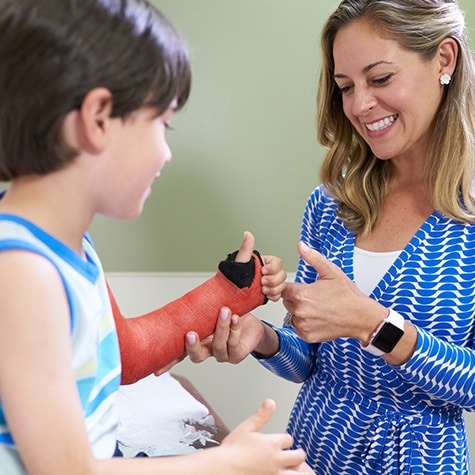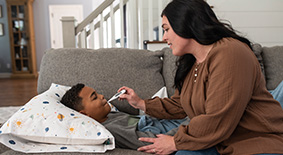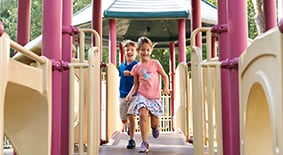Signs Your Child Has Broken a Bone and Where to Get Care
When you have an active kid, injuries happen. Bumps and bruises are to be expected. But knowing when an injury requires a trip to the doctor can be a challenge, especially if your child has a broken bone.
From climbing trees and riding bikes to playing their favorite sport, active kids are bound to take a tumble now and then. Most of the time, they can brush it off or take a quick time out and get back to having fun. But it’s important to be on the lookout for signs of a more serious injury like a broken bone, or a fracture, so that you can get your child the care they need.

Sprain Vs. Fracture: What’s the Difference?
Signs of a sprain
Sprains are injuries to ligaments, which are the soft tissues that connect bones at a joint. Signs of a sprain can include:
- Pain
- Swelling
- Bruising
Signs of a broken bone
Symptoms of broken bones may mimic those of a sprain, but they are typically more severe. Signs that your child may have a broken bone may include:
- Persistent pain
- Swelling, bruising or deformed appearance of the affected limb
- Difficulty moving the limb or pain during movement
- Inability to use the limb, to put weight on it or lift items with it
Sometimes, identifying a child’s broken bone can be a challenge. Children may not be able to judge or communicate the severity of their pain or tell you what part of their arm or leg is hurting. And in some cases, depending on where the break occurs, your child may only experience moderate pain or discomfort during normal movement, so it’s easy to assume the injury isn’t serious. Keep an eye out for noticeable changes in behavior, such as avoiding the use of an arm or leg, limping or withdrawing from fun activities, which may indicate the injury requires further evaluation.
Our pediatric orthopedic surgeon, Denver Kraft, MD, says there’s only one way to confirm your child has a broken bone: imaging the area with either an X-ray or MRI. “If a broken bone is suspected, typically an X-ray will be taken to both confirm and get a better idea of what kind of treatment may be needed to optimize the healing process,” she says. “Children’s bones are still developing and contain growth plates, which are less dense and can be difficult to distinguish from a broken bone on an X-ray. Pediatric orthopedists are highly trained in evaluating these subtle differences. Because we review pediatric imaging daily, we are uniquely equipped to accurately diagnose injuries and determine the most appropriate treatment plan for growing children.”
Not sure whether your child has a broken bone? The safest course of action is to seek prompt medical evaluation and imaging. Early diagnosis is key because many fractures can be treated with casting or bracing, often avoiding the need for surgery.
If your child has had multiple broken bones, Dr. Kraft suggests discussing their bone health, including vitamin D levels, with their pediatrician. “Adequate vitamin D is essential for developing strong, healthy bones, and deficiencies can sometimes lead to increased risk of broken bones,” she adds.
All broken bones need medical care to make sure that the break heals properly. If there’s pain, but you don’t see a bone coming through the skin, follow these steps to make your child as comfortable as possible until you can get them to the doctor:
- Cut away or gently remove clothing from the injured area if possible.
- Apply an ice pack wrapped in cloth to the area.
- Stabilize the injured area with a splint or support it with a cushion or a pillow. Use a strip of cardboard or a rolled-up newspaper secured with tape, an elastic bandage or a scarf as a makeshift splint. A sling made from towel or piece of cloth can also help keep an injured arm in place.
- Do not give your child anything to drink or eat in case surgery is required.
If your child’s bone is coming through the skin, call 911 or go to the nearest emergency department immediately. Do not try to push the bone back under the skin.

Different types of injuries require different levels of care, and it's not always easy to determine which is best for your child in the moment. Here are tips to help you decide.
Learn moreIf you suspect your child has a broken bone, it’s important to get them care quickly from a pediatric orthopedic specialist. At Children’s, we treat more kids’ broken bones than anyone else in Georgia. We understand growing bodies, and we know how to tailor treatment for broken bones to help kids heal properly and prevent long-term problems as they age.
“Everything we do is built around the unique needs of children. As a pediatric orthopedic surgeon, I see firsthand how this specialized environment benefits our patients. From child-friendly imaging technology to staff, X-ray techs, ortho techs and nurses who work exclusively with kids, every aspect of care is tailored to make kids feel safe, supported and understood. Our goal is not just to fix a broken bone, but to help each child return to being a kid with as little disruption as possible,” says Dr. Kraft.
Your child’s X-ray will be read by a board-certified pediatric radiologist. We also follow Image Gently guidelines, which means we reduce your child’s exposure to radiation by up to 50% compared to some adult facilities.
In addition to our Urgent Care Centers and three Emergency Departments, Children’s has dedicated orthopedic and sports medicine clinic locations across metro Atlanta.
For a parent, choosing Children’s means choosing a place where your child will be treated by people who have dedicated their entire careers to pediatric care. It means access to advanced treatments, innovative research and a compassionate team that understands how to communicate with both children and their families.
Denver Kraft, MD is a pediatric orthopedic surgeon who specializes in the diagnosis, treatment and management of pediatric musculoskeletal disorders. Dr. Kraft cares for a wide range of pediatric orthopedic conditions including hip and foot disorders, limb deformities, neuromuscular conditions, trauma and fractures, and she has clinical interest in spine deformities, including scoliosis. A graduate of the Albert Einstein College of Medicine, she completed her residency in orthopedic surgery before completing a fellowship in pediatric orthopedics at Texas Scottish Rite Hospital for Children. In addition to providing patient care, Dr. Kraft is actively engaged in academic research, has authored numerous publications and presented her work at conferences across the country.
This content is general information and is not specific medical advice. Always consult with a doctor or healthcare provider if you have any questions or concerns about the health of a child. In case of an urgent concern or emergency, call 911 or go to the nearest emergency department right away. Some physicians and affiliated healthcare professionals on the Children’s Healthcare of Atlanta team are independent providers and are not our employees.
Contact Us 404-255-1933





